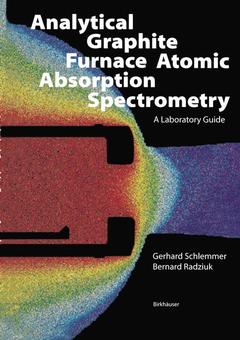1 AAS: a simple and rugged system for trace and ultratrace elemental analysis.- 1.1 The physical background.- 1.2 Light sources, their properties and how to obtain maximum intensity and lifetime.- 1.3 Monochromators, polychromators and other optical components: from lines to plane.- 1.4 Detectors in AAS: the revolution has just begun.- 1.5 Improving selectivity: about light modulation, photon integration, continuum sources and magnetic fields.- 1.6 A little bit about flames and a lot more about graphite furnaces for generation of atom clouds.- 1.6.1 Safety aspects and laboratory prerequirements for graphite furnace systems.- 2 Important terms and units for analytical atomic spectrometry.- 2.1 Sensitivity and characteristic mass: the way to check your spectrometer.- 2.2 Precision or detection limit: what’s the name of the game?.- 2.3 Working range of graphite furnace AAS: linear and nonlinear curves and ways to linearize nonlinear functions.- 2.4 Calibration in AAS or: never underestimate the importance of the standard.- 2.5 Effects and interferences: the harmless and the dangerous effects of matrix.- 2.6 Means and methods to provide quality assurance in AAS.- 3 Even theory can be fun: the exciting growth of knowledge in electrothermal AAS.- 3.1 History of graphite furnaces.- 3.2 Empirical observations: the stability of the characteristic mass m0.- 3.3 The dynamic temperature behaviour of a Massmann-type furnace and a Transversely Heated Graphite Atomizer.- 3.4 Chemical reactions in a gas phase at elevated temperatures enclosed by graphite.- 3.5 The influence of tube wall and platform on the atomization pulse.- 3.6 Statistical model.- 3.7 Graphite is an impressive material — but somehow and sometimes it is still black magic.- 4 Developing a method in GFAAS.- 4.1 Basic checks or “o.k., the whole thing is doing what it’s supposed to”.- 4.1.1 Automatic checks on modern instruments.- 4.1.2 Spectrometer.- 4.1.3 Graphite furnace.- 4.1.4 Blank and reference solutions including modifier.- 4.1.5 Characteristic mass.- 4.1.6 Simultaneous multielement GFAAS.- 4.2 Screening may be sufficient and may save a lot of time and annoyance.- 4.3 Systematic development of a GFAAS method: accuracy, precision, speed, long term stability.- 4.3.1 Basic considerations.- 4.3.2 Drying.- 4.3.3 Pyrolysis.- 4.3.4 Atomization.- 4.3.5 Analytical quality and long term stability.- 4.3.6 Speed.- 4.4 Chemical modifiers: the spectroscopist’s box of tricks.- 4.4.1 Modifiers which influence the thermal stability or the chemical activity of the the matrix (matrix modifiers).- 4.4.2 Modifiers which thermally stabilize the analyte element(s), or “Eureka! There is a universal modifier!” from the vantage point of 12 years after its introduction.- 4.4.3 Using modifiers properly.- 4.4.4 Modifiers which are active in combination with the graphite surface in the solid phase.- 5 The first step is sample pretreatment.- 5.1 Using the right method for sample pretreatment is half the analysis.- 5.2 Autosamplers, the universal sample management systems.- 5.3 A liquid is not necessarily a prerequirement: about solids and slurries.- 5.4 Ways to separate matrix and preconcentrate analyte.- 5.5 Analyte in gaseous molecular form: horror or benefit?.- 6 Use and abuse of microprocessors.- 6.1 A peak will tell you more than 1000 numbers.- 6.1.1 What do we see on the screen?.- Blank firings.- Absorbance by analyte only.- Background only.- 6.2 Everything you need may be in your PC’s memory.- 6.3 Check functions and quality control.- 6.3.1 Calibration: range, precision, recovery.- 6.3.2 Quality control samples: accuracy and long term stability of results.- 6.3.3 Accuracy of the entire analytical procedure.- 6.4 What’s to be done with all the data?.- 7 Patience Clever’s exciting voyage through the world of matrices and challenging analyses.- 7.1 Ultra pure water and chemicals.- 7.1.1 Keeping contamination under control.- 7.1.2 Optimization of the photometric noise.- 7.1.3 Graphite furnace time/temperature programs.- 7.1.4 Recoveries.- 7.1.5 Detection limits.- 7.2 Surface water, mineralized water, sea water and waste water.- 7.3 Sediments, soils and sludges.- 7.4 Plants and other biological tissue.- 7.5 Clinical samples.- 7.6 Oil and fat.- 7.7 Clean samples which are difficult to dissolve: the analysis of slurries.




